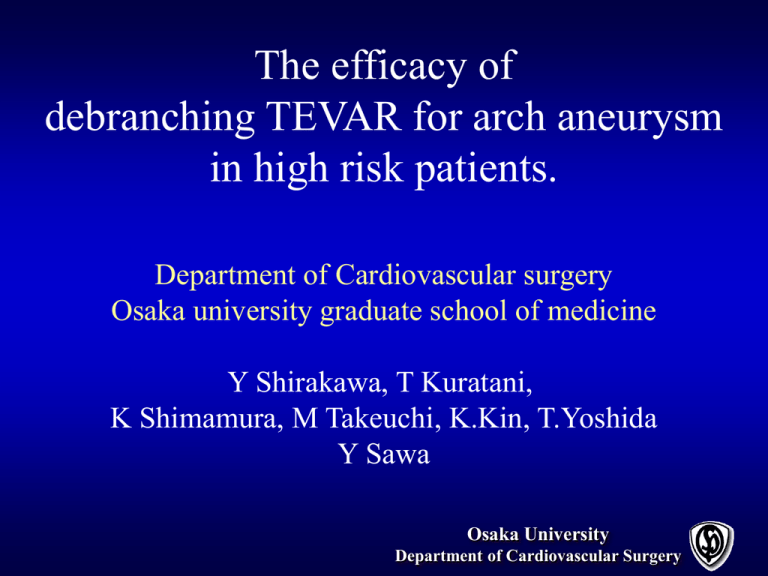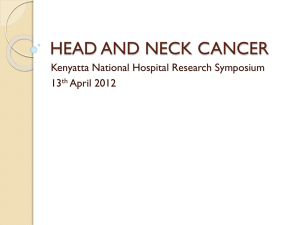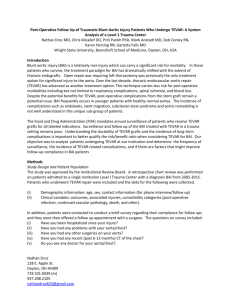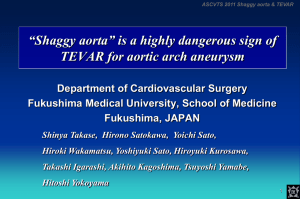
The efficacy of
debranching TEVAR for arch aneurysm
in high risk patients.
Department of Cardiovascular surgery
Osaka university graduate school of medicine
Y Shirakawa, T Kuratani,
K Shimamura, M Takeuchi, K.Kin, T.Yoshida
Y Sawa
Osaka University
Department of Cardiovascular Surgery
Background
The traditional treatment of thoracic aortic aneurysms is open
surgical graft replacement. Despite progressive surgical advances,
conventional surgical repair is still associated with substantial
morbidity and mortality, especially in elderly patients with other
major medical conditions.
Aortic arch aneurysms present a particular challenge to
endovascular repair due to the involvement of supra-aortic vessels
and the anatomic curvature of the arch. A variety of maneuvers have
been recommended for thoracic endografting to address the landing
zone limitations imposed by the arch vessels.
Osaka University
Department of Cardiovascular Surgery
Objectives
This report presents the results of a review of our 10-year clinical
experience with endovascular treatment of aortic arch aneurysms
after debranching of arch vessels (debranching TEVAR).
Osaka University
Department of Cardiovascular Surgery
Debranching TEVAR
Number of Patients : 90 cases
(Jan. 1998 ~ Nov. 2009)
Sex : Male 65, Female 25
Age : 68.9 ±11.7 (27~95) years old
pathology
Type B dissection
37 cases(acute case 10)
Degenerative
44 cases (rupture case 4)
Infective/inflammatory
3 cases
Traumatic
4 cases
cancer invasion
2 cases
co-morbidity
High age (over 80 y.o)
17 cases (18.8 %)
COPD
30 cases (33.3 %)
Logistic
Euroscore
: 15.93% +/9.77 %
(2.76
Concomitant
cancer
17 cases
(18.8
%)~ 43.67)
CAD
12 cases (13.3 %)
previous cardiac surgery 4 cases (4.4 %)
Osaka University
Department of Cardiovascular Surgery
Debranching TEVAR
Proximal landing zone
Arch reconstruction procedure
Zone 0
Ao-rt.SCA-lt.CCA-lt.SCA bypass
9
bil.FA-rt.SCA-lt.CCA-lt.SCA bypass 1
19
10
61
Zone 1
rt.SCA-lt.CCA-lt.SCA bypass
Zone 2
rt.SCA-lt.SCA bypass
lt.CCA-lt.SCA bypass
Simple sacrifice of lt.SCA
Osaka University
Department of Cardiovascular Surgery
19
32
5
24
Ao-rt.SCA-lt.CCA-lt.SCA bypass
Approach : Median sternotomy
Inflow : Side clamp of Ascending Aorta.
Prosthesis : 12mm Hemashield for rt. SCA
8mm Hemashield for
lt.CCA & lt.SCA
Ao – rt. SCA bypass ~ avoid direct clamp of BCA
Osaka University
Department of Cardiovascular Surgery
Debranching TEVAR
Early results
Primary success
97.8% (88/90)
type Ⅰb ~ 1, type Ⅱ~ 1
30 days Mortality
1.1 % (1/90)
due to iliac rupture
Postopeative Complication
Stroke
2 (2.2%) (Z2 ~ 2)
Respiratory failure 1 (1.1%)
Paraplegia
0
Osaka University
Department of Cardiovascular Surgery
Debranching TEVAR
Late results
(%)
100
Freedom from
aneurysm related death
(%)
All cause survival
100
80
80
60
1 year
3 year
5 year
10 year
40
20
0
88.1 %
77.2%
69.5%
69.5%
60
1 year
3 year
5 year
10 year
40
20
96.7 %
93.6%
84.2%
84.2%
0
1
3
5
7
10
(y)
1
3
5
7
10
(y)
Osaka University
Department of Cardiovascular Surgery
Debranching TEVAR
Freedom from Aortic event
(%)
1 year
3 year
5 year
10 year
100
80
60
96.5 %
83.1%
83.1%
69.3%
Re-TEVAR 3
distal enlargement 1
typeⅠb endoleak 2
in dissection case.
Open conversion 1
Graft infection 1
Rupture 1
40
20
0
1
3
5
7
10
(y)
Osaka University
Department of Cardiovascular Surgery
Discussion
Freedom from Aortic events
Operative mortality : 4.3 %
In-hospital mortality : 7.2 %
Strokes : 5.8 %
Paraplegia : 2.9 %
Osaka University
Department of Cardiovascular Surgery
Strategy for Arch Aneurysm
Arch and distal arch aneurysm
Patients condition
Anatomical
condition
First choice
Open Surgery
High
risk
patients
First
choice
Debranched TEVAR
Anatomical limitations
• Proximal neck
diameter 34 ~ 37mm, length 20mm
diameter 23 ~ 33mm, length 15mm
•Character of Aortic wall (ascending
aorta)
Osaka University
Department of Cardiovascular Surgery
Conclusion
Debranched TEVAR for aortic arch aneurysms appears to reduce
the early mortality and morbidity and long-term durability is very
acceptable.
Our results suggested that this procedure might be an alternative
procedure for low risk patients.
In the future, ready made branched endoprostheses will be
installed, which may expand the applications of this procedure.
Osaka University
Department of Cardiovascular Surgery










